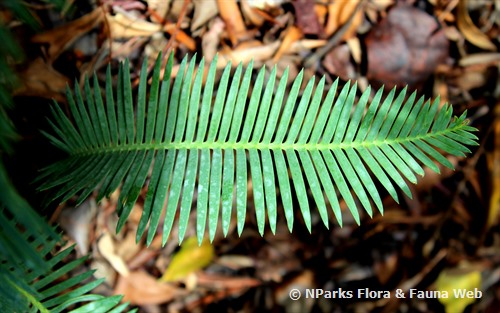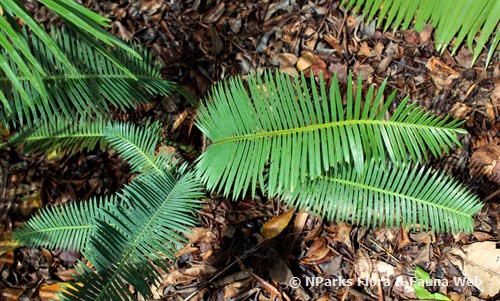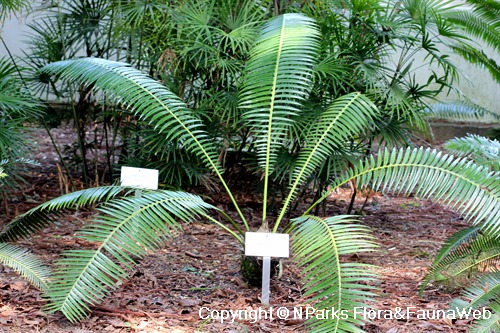
Back
Dioon sonorense (De Luca, Sabato & Vázq. Torres) Chemnick, T.J. Greg. & Salas-Mor.
| Family Name: | Zamiaceae |
| Common Name: | 索诺拉双子铁 |
Name
Classifications and Characteristics
| Plant Division | Gymnosperms (Non-Flowering Seed Plants) (Cycad) |
|---|---|
| Plant Growth Form | Cycad |
| Lifespan (in Singapore) | Perennial |
Biogeography
| Native Distribution | Mexico (Sinaloa, Sonora) |
|---|---|
| Native Habitat | Terrestrial |
| Local Conservation Status | Non-native |
Description and Ethnobotany
| Growth Form | It is a cycad, up to 1 m tall. Trunk is cylindrical and covered with persistent leaf bases. |
|---|---|
| Foliage | Mature leaves are grey-green, stiff and erect (0.8 – 1.5 m long). Petiole is 6 – 20 cm long, swollen at the base and lacks spines. Each leaf comprises of 100 – 150 narrowly lanceolate leaflets with 1 – 3 small spines at the leaflet margin. |
| Reproductive Parts - non-flowering plant | Male cone is cylindrical (25 – 50 cm long and 6 – 10 cm wide) while female cone is ovoid (20 – 30 cm long and 15 – 20 cm wide) and woolly. Seed is oval-shaped (2 – 2.5 cm long and 2.5 – 3.5 cm wide), with cream to red seed coat. |
| Habitat | It is found on mountainous slopes, 600 – 1200 m altitude. |
Landscaping Features
| Landscape Uses | Parks & Gardens |
|---|---|
| Usage Hazard - Cons | Spines/Thorns - Leaf |
Plant Care and Propagation
| Light Preference | Full Sun |
|---|---|
| Water Preference | Little Water |
| Plant Growth Rate | Slow |
| Rootzone Tolerance | Well-Drained Soils |
Foliar
| Mature Foliage Colour(s) | Green |
|---|---|
| Mature Foliage Colour(s) Remarks | bluish green |
References
| References | Jones, D.L. 2002. Cycads of the World. Ancient Plants in Today's Landscape. 2nd Edition. United States of America: Smithsonian Institution Press. 456 |
|---|
Image Repository
Others
| Master ID | 32954 |
|---|---|
| Species ID | 7368 |
| Flora Disclaimer | The information in this website has been compiled from reliable sources, such as reference works on medicinal plants. It is not a substitute for medical advice or treatment and NParks does not purport to provide any medical advice. Readers should always consult his/her physician before using or consuming a plant for medicinal purposes. |


